Goal Area 3: Promoting Quitting
The CDC says that quitting smoking is difficult because of the addictive nicotine that cigarettes rapidly deliver to the brain. Smoking leads to dependence, and quitting often leads to withdrawal. Smoking also becomes part of a person’s daily routine, making it even harder to stop.
The SUTPP and the CDC share the goal of reducing the health burdens of commercial tobacco and nicotine use by promoting and supporting quitting among adults and youth.
In this section, WYSAC explores the desire to quit among adults who currently use commercial tobacco and their quit attempts. WYSAC looks at awareness of quitlines, use of quit aids, and barriers to quitting. This section also covers visits to healthcare providers and conclusions and recommendations based on the data and best practices in helping people quit.
Efforts to Quit Smoking
Desire to Quit Among Adults Who Smoke
More than half (66%) of adults who currently smoke want to quit smoking cigarettes. The nine percentage-point difference between 2021 and 2023 was not significant. There were no significant changes from 2015 to 2023 (Figure 20).
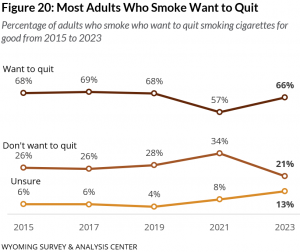
Quit Attempts Among Adults Who Smoke
At some point in their lives, the majority of adults who currently smoke (87%) had stopped smoking for at least one day because they were trying to quit for good.
Nearly half (45%) of adults who currently smoke have tried to quit smoking at least once in the past year because they were trying to quit for good (Figure 21).
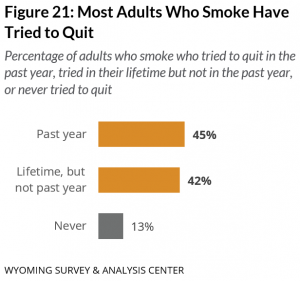
Smokers’ quit attempts have not changed significantly between 2010 and 2023.
Aids to Quit Smoking
Awareness of Quitlines
Most (77%) adults who use commercial tobacco or nicotine (including ENDS) were aware of telephone quitline services (Figure 22). About half (45%) of adults who do not use commercial tobacco or nicotine were aware of telephone quitline services.
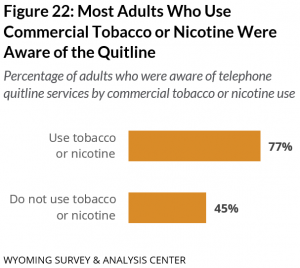
This may demonstrate the success of media campaigns by SUTPP and their partners, including county-level efforts.
Use of Quit Aids Among Adults Who Currently Smoke
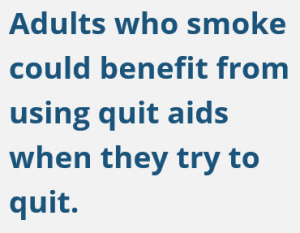 More than half (54%) of adults who currently smoke and tried to quit in the last year did not use any quit aids. Nicotine replacement therapy (NRT) was the most popular aid used by adults who smoke (Figure 23). This may have included people buying them over the counter themselves or getting them from the Wyoming Quit Tobacco (WQT) program.
More than half (54%) of adults who currently smoke and tried to quit in the last year did not use any quit aids. Nicotine replacement therapy (NRT) was the most popular aid used by adults who smoke (Figure 23). This may have included people buying them over the counter themselves or getting them from the Wyoming Quit Tobacco (WQT) program.

Obstacles to Quitting Cigarettes Among Adults Who Smoke
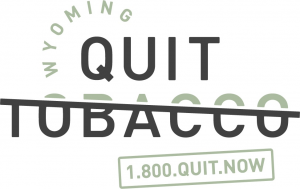 Cravings for a cigarette was the most common obstacle for adults who smoke and tried to quit in their lifetime or wanted to quit (84%; Figure 24). The second most common obstacle to quitting cigarettes was the loss of a way to handle stress (74%). The WQT program specifically targets the most common obstacle to quitting smoking (https://www.quitwyo.org). In particular, the medications provided are designed to reduce cravings. Coaching can include strategies to deal with other obstacles, such as losing a way to handle stress.
Cravings for a cigarette was the most common obstacle for adults who smoke and tried to quit in their lifetime or wanted to quit (84%; Figure 24). The second most common obstacle to quitting cigarettes was the loss of a way to handle stress (74%). The WQT program specifically targets the most common obstacle to quitting smoking (https://www.quitwyo.org). In particular, the medications provided are designed to reduce cravings. Coaching can include strategies to deal with other obstacles, such as losing a way to handle stress.
In addition, 62% reported that other people smoking around them is an obstacle to quitting smoking. These adults could benefit from increased smokefree air policies in their environments.
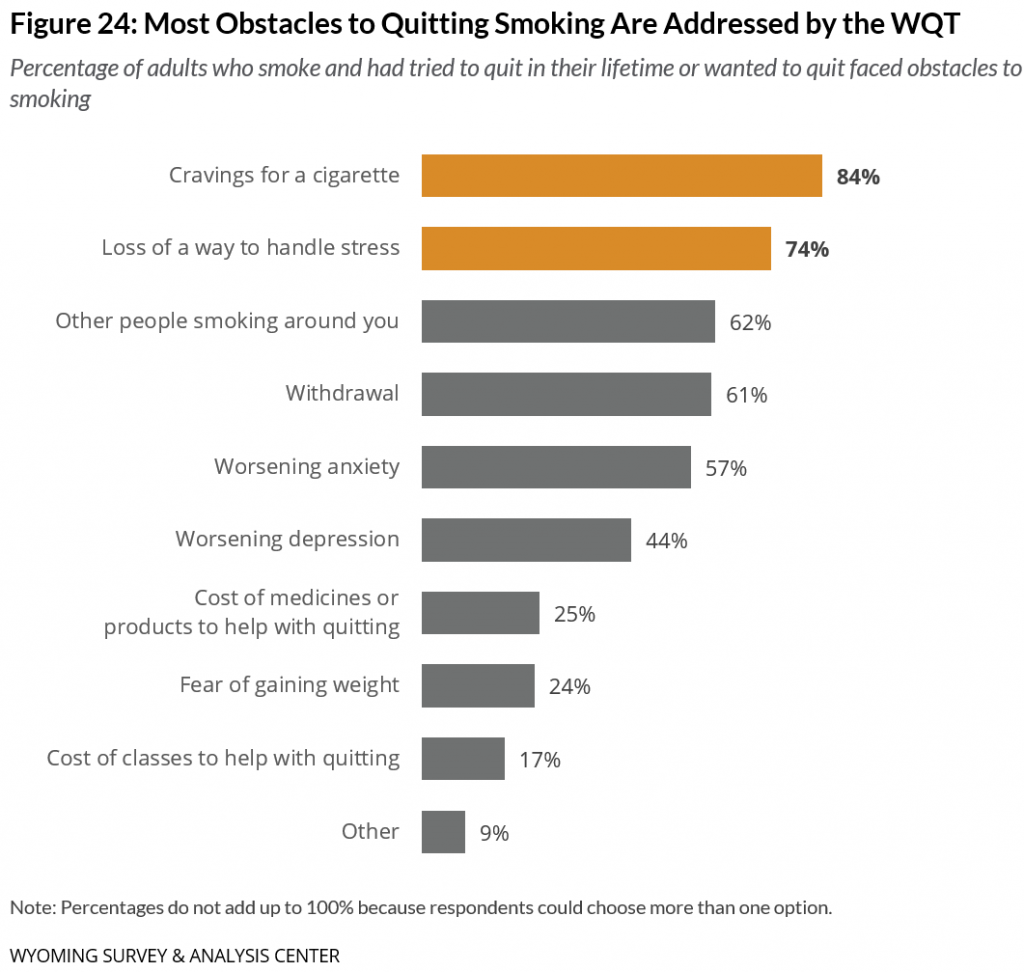
Health Professionals’ Involvement in Quitting Commercial Tobacco or Nicotine Use
Visits with Health Professionals
The 2023 Adult Tobacco Survey asked respondents if they had seen a health professional (a doctor, dentist, nurse, or another health professional) in the past year and, if so, if the health professional asked if they smoked cigarettes or used any other commercial tobacco or nicotine products, including ENDS.
In 2023, 28% of adults used commercial tobacco or nicotine while 72% did not. Most adults who use commercial tobacco or nicotine had seen a health professional in the past year (74%; Figure 25). Commercial tobacco or nicotine use was related to lower likelihood of seeing a health professional. This difference might be due, in part, to barriers to seeking care that might be linked to other related factors, such as lower income.
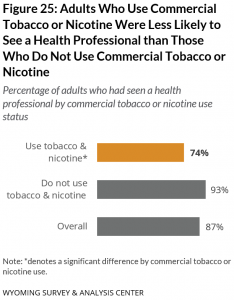
Patient Experiences with Health Professionals’ Support for Quitting Commercial Tobacco and Nicotine Use
Adults are often asked about their commercial tobacco or nicotine use when visiting a health professional. In 2023, 78% of all adults were asked if they smoked cigarettes or used any other commercial tobacco or nicotine products. Adults who used commercial tobacco or nicotine (88%) were more likely to be asked if they smoked cigarettes or used any other commercial tobacco or nicotine products than adults who did not use commercial tobacco or nicotine (74%).
WYSAC does not know to what extent health professionals use medical records to screen for commercial tobacco or nicotine use during a visit. This may have been a limitation when health professionals did not ask about commercial tobacco or nicotine use because they already had records of it.
Less than half (26%) of commercial tobacco or nicotine users were offered assistance with quitting, even when focusing on those who say a professional asked them about their commercial tobacco or nicotine use (Figure 26).
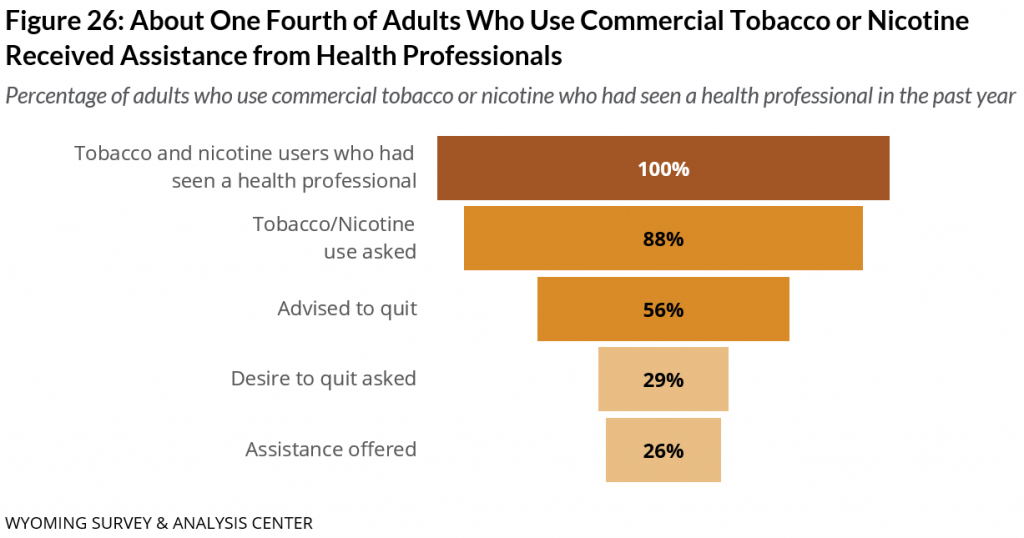
 When adults who use commercial tobacco or nicotine were offered assistance, health professionals provided WQT information (78%; Figure 27), recommended NRTs (50%), and prescribed medication (18%). These protocols align with best practices in support of quitting.
When adults who use commercial tobacco or nicotine were offered assistance, health professionals provided WQT information (78%; Figure 27), recommended NRTs (50%), and prescribed medication (18%). These protocols align with best practices in support of quitting.
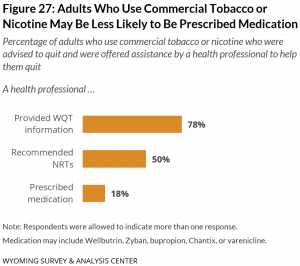
Conclusion
Most smokers want to quit smoking cigarettes and have tried to quit at some point in their lives. When they try to quit or want to quit, adults who use commercial tobacco or nicotine face obstacles such as cravings for a cigarette, loss of a way to handle stress, and others smoking around them. The WQT program is designed to assist with most of these obstacles.
Most adults who use commercial tobacco or nicotine are aware of quitline services. Nearly half of adults who had tried to quit in the last year used a quit aid the last time they tried to quit. However, only one in four (26%) reported using WQT the last time they tried to quit.
Education and media emphasizing how the WQT program addresses common barriers to quitting smoking may increase enrollment in the WQT program. Additionally, the use of WQT program offerings (such as NRT and medications) can then increase the chances of adults quitting.
Visits to health professionals are opportunities for connecting current commercial tobacco or nicotine users to available resources and addressing barriers to quitting. Most adults were asked by a health professional if they used commercial tobacco or nicotine products. Adults who use commercial tobacco or nicotine were less likely to report that health professionals followed up or offered help with quitting than being asked about their use. Greater collaboration with health professionals could result in more commercial tobacco or nicotine users becoming aware of, and receptive to, services that could increase their chances of quitting (CDC, 2015).

